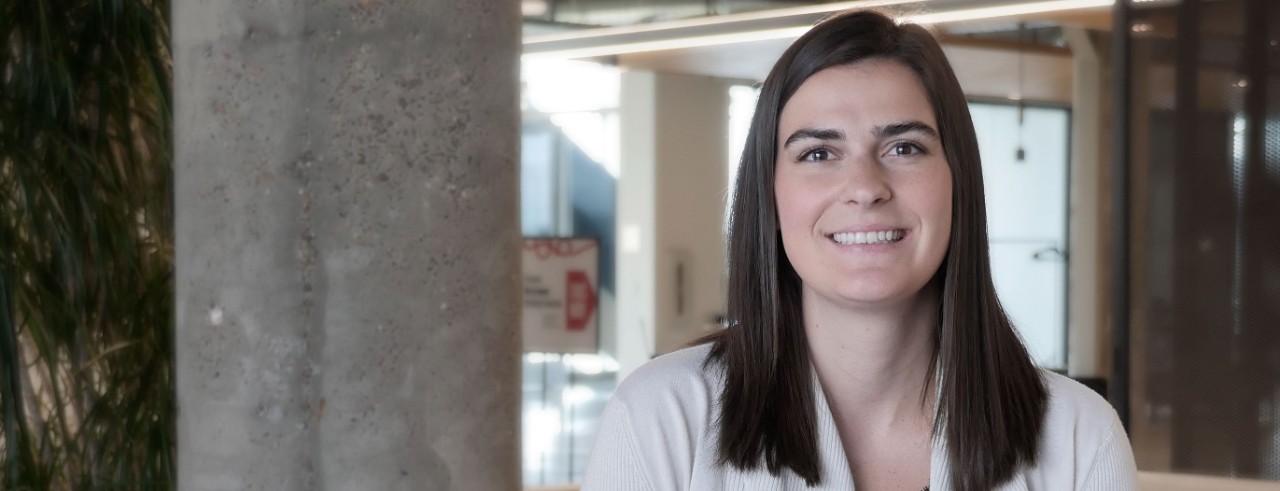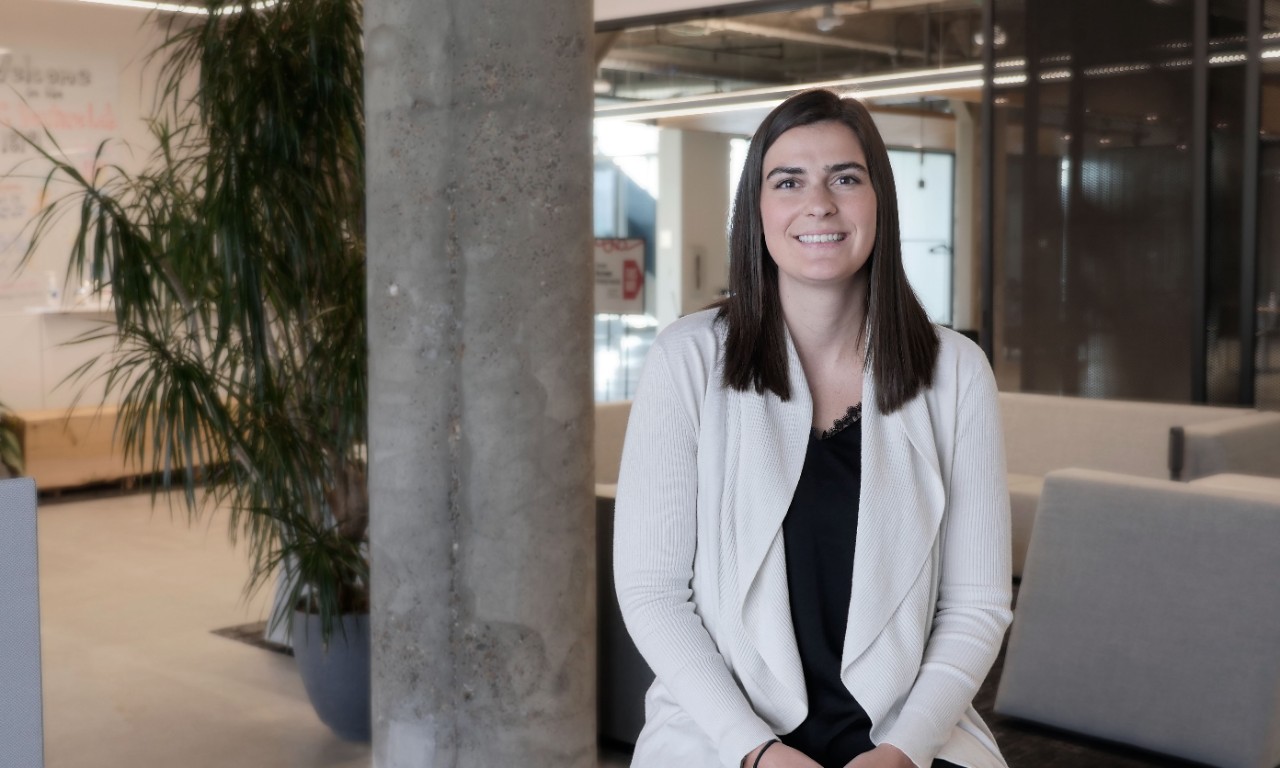
UC startup aims to reinvent physical therapy
Band Connect develops technology to create in-clinic experience at home
A University of Cincinnati Venture Lab-backed startup is looking to reinvent the physical therapy market with a new approach that offers hope for a more effective and more convenient way to provide treatment.
The startup, Band Connect, has created technology that allows an in-clinic experience for physical therapy patients at home while providing clinicians insight into their patients’ form and progress. Band Connect is planning a beginning round of funding of $3 million in the first quarter of 2023, which will enable its planned advancement activities.
Band Connect is outfitting fitness equipment that’s already in use in clinics today with technology that tracks users’ movements and integrates the data into the physical therapy workflow. Sensors in the handles of the fitness equipment allow physical therapists to monitor their patients’ progress remotely after the workout is complete.
“Physical therapy hasn't changed since it started,” Band Connect co-founder Abby McInturf, a 2018 UC alumna, said. “Patients are still using sheets of paper handouts with stick-figure drawings, and only 35% of patients are compliant with their plans of care today. By providing insight into what the patients are doing at home, we're creating a better relationship between the physical therapist and the patient by increasing the communications pathways.”

Abby McInturf, Band Connect’s co-founder, is a 2018 graduate of UC’s College of Design, Architecture, Art, and Planning (DAAP).
Band Connect is one of the many startups that have come out of the UC Venture Lab pre-accelerator program and received seed funding.
UC’s Venture Lab, operated by the Office of Innovation, provides a launch pad for entrepreneurs to turn their ideas into a startup reality. The UC Venture lab is located in the 1819 Innovation Hub in the Cincinnati Innovation District (CID), providing a connection point to talent, support and funding to help launch new companies.
“That was incredibly helpful,” McInturf said of going through the Venture Lab’s pre-accelerator program. “The Venture Lab gave us the resources and me as a student the confidence to start this right out of school. They've been incredibly helpful since we've left as well so it wasn't just about that seven- or eight-week program. We're still in contact with them every week.”
The Venture Lab pre-accelerator program is available for free to all members of the university community. The program provides guidance to launching a startup and pairs aspiring entrepreneurs with executives for mentoring.
“We are thrilled to provide the place for innovators like Abby to convene, for ideas like hers to take shape and for startups like Band Connect to excel,” said David J. Adams, UC’s chief innovation officer. "Great things happen when talent and innovation intersect, and that’s what we’re proud to facilitate at the Cincinnati Innovation District. The results are clear.”
The Venture Lab gave us the resources and me as a student the confidence to start this right out of school.
Abby McInturf Band Connect co-founder
McInturf founded Band Connect in 2018, shortly after she graduated from UC’s College of Design, Architecture, Art, and Planning (DAAP). As a student, she researched ways to reduce concussions among women’s soccer players, and later she joined the first cohort of the Venture Lab’s pre-accelerator program to develop her research into a business.
Through the Venture Lab, McInturf met Band Connect co-founder Rohit Nayak, an entrepreneur-in-residence, and discovered her technology could have applications in physical therapy and musculoskeletal rehabilitation.
“It was through that process we recognized a greater need in the physical therapy space, so we pivoted the product to a platform and pivoted into the physical therapy space,” McInturf said.
Band Connect currently is focusing on equipment to accommodate non-strength and strength-based exercises for post-acute and chronic mid-back, shoulder and neck conditions. The startup’s platform can support more than 50 exercises for the upper extremities of the body, with future developments to focus on other parts of the body.
The exercises can be completed and monitored asynchronously using tracking technology within the handles of the equipment, so no cameras are needed.
“That's a huge benefit we've seen from talking to customers,” McInturf said. “There's no cameras or strap-on sensors, so the patient is able to just pick up the device and use it.”
With objective data collected through the connected technology, Band Connect allows patients to know they’re completing their exercises properly and getting the maximum benefit. The technology also allows greater communication between physical therapists and their patients while reducing the need for in-clinic visits.
“We're enabling real-time biofeedback at home so the patient is able to replicate what they did in the clinic,” McInturf said. “We're providing the equivalent level of care but reducing the frequency of in-clinic visits.”
For clinicians, not only do they gain valuable insight and greater communication with their current patients, they also have the ability to see more patients as fewer in-clinic visits opens up more time in their schedules. This could be very valuable, McInturf said, as the United States faces a shortage of physical therapists.
The technology also should encourage patients to remain engaged in their physical therapy longer as the burdens of having to visit their physical therapist are removed.
As a result of the COVID-19 pandemic, McInturf thinks patients and clinicians have grown more accepting of telehealth, which will benefit Band Connect in encouraging people to use its products. Plus, the recently launched reimbursements for certified medical devices that support remote therapeutic management has catalyzed the interest in Band Connect’s solution and has created a backlog of interested health systems for its commercial deployment.
“We were thinking about this before the pandemic came about, and nobody was really talking about this space,” she said. “Once the pandemic hit, everything kind of exploded with telerehab and digital health and telehealth visits and things like that. I think patients are more receptive to taking telerehab care or telehealth care.”
Great things happen when talent and innovation intersect, and that’s what we’re proud to facilitate at the Cincinnati Innovation District.
David J. Adams UC’s chief innovation officer
Band Connect already is gaining interest in its products as it prepares for an initial round of funding.
Soon the startup will launch two clinical trials with health systems in the Cincinnati region. Both trials will enroll 60 patients and last approximately 12 to 14 weeks.
Also, Band Connect will host a pilot trial through the U.S. Army’s Telemedicine & Advanced Technology Research Center.
“We're really excited about the feedback we've gotten from health systems around the region and just excited about the clinicians that we've been talking to and that engagement,” McInturf said.
Featured image at top: Abby McInturf, Band Connect’s co-founder, joined the Venture Lab shortly after graduating from UC. Photos by Gregory Glevicky/UC Office of Innovation
About UC Venture Lab
A leading model for urban-centered universities, the UC Venture Lab activates a high density of rapidly curated startup opportunities that attract outside entrepreneurial talent and investors. We connect university students, faculty, staff, and alumni to talent and funding to help launch new companies. Our team includes Office of Innovation staff as well as Entrepreneurs-in-Residence (EIRs), coaches, curated service providers, and subject matter experts.
About the Cincinnati Innovation District
The Cincinnati Innovation District® is a unique and thriving ecosystem that attracts, produces, retains and develops talent by co-locating and collaborating with organizations. Unveiled in 2020 by Ohio Governor Mike DeWine and Lt. Governor Jon Husted along with JobsOhio and innovation district leadership, the district envelops myriad innovation assets and access to some of the world’s leading academic and research centers, organizations and talent pools. Powered by the University of Cincinnati, the CID includes the world-renowned Cincinnati Children’s Hospital Medical Center and other national research centers. The district’s mission is to become a globally recognized talent hub and lead a transformational movement. The combination of industry engagement, unique experiential platforms and accessible research expertise — working at the pace of change — will become a model nationwide. For more information on the Cincinnati Innovation District, visit www.cincyid.com.
Related Stories
Nursing innovation comes to life at UC’s 1819 Innovation Hub
February 28, 2025
Chief nursing officers from across Greater Cincinnati gathered at UC’s 1819 Innovation Hub to celebrate the profession’s many contributions and to highlight the potential for cutting-edge healthcare advances.
UC's Bearcats Pantry and Resource Center opens new digs
February 27, 2025
UC officials opened new space for the Bearcats Pantry and Resource Center with a grand reopening and ribbon-cutting ceremony on Tuesday, Feb. 25. The new pantry space is on the main floor of Stratford Heights, Building 16, on the Uptown campus.
1819 Innovation Hub carries statewide influence to Columbus
February 27, 2025
Ohio leaders looked to UC’s 1819 Innovation Hub throughout 2024 as the state’s front-runner in innovation expertise and technological know-how.
